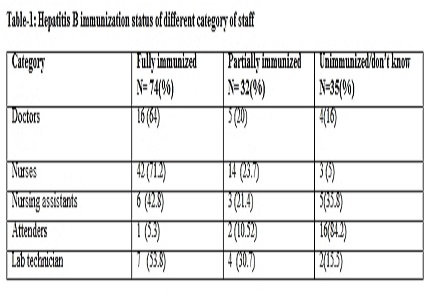Safety concerns over biomedical waste management in a tertiary care centre of North Kerala
Abstract
Introduction: Exposure to infected body fluids and contact with contaminated materials while handling bio medical waste make health workers at high risk for blood borne infections.
Objective: To assess safety precaution profile and biomedical waste management practices among different categories of health staff.
Materials and methods: A cross sectional study was conducted among 141 health care personnel of a tertiary care center on single shift of a day using a structured pre- tested interview schedule. Data were analyzed using SPSS 16 trial version.
Results: The study population included 25(17.6%) doctors, 59(41.5%) nurses, 14(9.9%) nursing assistants, 19(13.4%)hospital attendants and 13(9.2%) lab technicians and 11(7.8%) other daily wage cleaning staff involved in waste management. 104 (73.8%)were females. 91(64.5%)were permanent staff while 50 were on contract. 121(89.4%) had work experience more than 1year.71(50.4%)received no training on bio medical waste management and 18 (12.8%) had training within 6 months. Only 74(52.1%) were fully immunized against Hepatitis B with a significantly less coverage among nursing assistants and hospital attendants (p=.000). 60(42.6%)had sharp injury male sex (p=.042), being in category of nursing assistants (p=.000), permanent job status (p=.000) and experience more than 5 years in absence of training (p=.010) were risk factors significantly associated with sharp injury.101(72.3%) always segregated waste as per categories and 110(78% ) always used gloves while handling it.
Conclusions: Around half of the health personnel are not following safety practices and sustained sharp injuries while handling biomedical waste. Only half of the health personnel were immunized against Hepatitis B.
Downloads
References
2. Pruss A, Ciroult E, Rushbrook P. Safe Management of Wastes From Health-Care Activities. Geneva: WHO; 1999. Definition and Characterization of Health-Care Waste; 20–27.
3. Pruss-Ustun A, Rapiti E, Hutin Y. Sharps injuries: Global burden of disease from sharps injuries to health-care workers. Geneva: World Health Organization; 2003. (WHO Environmental Burden of Disease Series, No. 3)
4. Meireles LC, Marinho RT, Van Damme P.Three decades of hepatitis B control with vaccination.World J Hepatol. 2015 Aug 28;7(18):2127-32. doi: 10.4254/wjh.v7.i18.2127. [PubMed]
5. Jhanvi G ,Raju PV. Awareness and training need of biomedical waste management among undergraduate students,AndhraPreadesh. Indian J Public health.2006;50(1):53-4. [PubMed]
6. Hanumantha Rao.P.hospital Management system-a case study of a South Indian city.Waste Manag Res 2009Jun;27(4):313-21. doi: 10.1177/0734242X09104128. Epub 2009 May 26. [PubMed]
7. Acharya D B,Singh Meeta .The Book of Hospital Waste Management . New Delhi . Minerva Press .2000;15,47.
8. Lin HH, Wang LY, Hu CT, Huang SC, Huang LC, Lin SS etal. Decline of hepatitis B carrier rate in vaccinated and unvaccinated subjects: sixteen years after newborn vaccination program in Taiwan. J Med Virol.2003;69(4):471–4.
9. Leuridan E, Van Damme P. Hepatitis B and the need for a booster dose. Clin Infect Dis. 2011;53(1):68–75. doi: 10.1093/cid/cir270.
10. Zanetti AR, Mariano A, Romanò L, D’Amelio R, Chironna M, Coppola RC, Long-term immunogenicity of hepatitis B vaccination and policy for booster: an Italian multicentre study. Lancet. 2005;366(9494):1379–84. [PubMed]
11. Liao SS, Li RC, Li H, Yang JY, Zeng XJ, Gong J etal. Long-term efficacy of plasma-derived hepatitis B vaccine: a 15-year follow-up study among Chinese children.Vaccine. 1999; 17(20-21):2661–6. [PubMed]
12. Yuen MF, Lim WL, Chan AO, Wong DK, Sum SS, Lai CL. 18-year follow-up study of a prospective randomized trial of hepatitis B vaccinations without booster doses in children. Clin Gastroenterol Hepatol. 2004;2(10):941–5. [PubMed]
13. Sukriti, Pati NT, Sethi A, Agrawal K, Agrawal K, Kumar GT, et al. Low levels of awareness, vaccine coverage, and the need for boosters among healthcare workers in tertiary care hospitals in India. J Gastroenterol Hepatol. 2008;23(11):1710–5. doi: 10.1111/j.1440-1746.2008.05483.x. Epub 2008 Aug 28. [PubMed]
14. Simard EP, Miller JT, George PA, Wasley A, Alter MJ, Bell BP etal. Hepatitis B vaccination coverage levels among healthcare workers in the United States, 2002-2003. Infect Control Hosp Epidemiol. 2007 Jul;28(7):783-90. Epub 2007 may 24. [PubMed]
15. Talaat M, Kandeel A, El-Shoubary W, Bodenschatz C, Khairy I, Oun S etal. Occupational exposure to needlestick injuries and hepatitis B vaccination coverage among health care workers in Egypt. Am J Infect Control. 2003 Dec;31(8):469-74.
16. Rasheed S, Iqbal S, Baig LA, Mufti K. Hospital waste management in the teaching hospitals of Karachi. J Pak Med Assoc. 2005;55(5):192–5. [PubMed]
17. Ullah JH, Ahmed R, Malik JI, Khan MA. Outcome of 7-S, TQM technique for healthcare waste management. J Coll Physicians Surg Pak. 2011;21(12):731–4.doi:12.2011/JCPSP.731734. [PubMed]
18. Ananthachari K. R., Divya CV. A study on assessment of knowledge on biomedical waste management among health care workers of Malabar Medical College Teaching Hospital, Calicut, Kerala, India.Int J Community Med Public Health. 2016 Sep;3(9):2409-13. http://dx.doi.org/10.18203/2394-6040.ijcmph20163038.
19. Ramesh Kumar, Babar Tasneem Shaikh, Ratana Somrongthong, Robert S Chapman. Practices and challenges of infectious waste management: A qualitative descriptive study from tertiary care hospitals in Pakistan. Pak J Med Sci. 2015 Jul-Aug; 31(4): 795–798. doi: 10.12669/pjms.314.7988.
20. Partha Sarathy,Naidana,,Neelima Surapaneni. A study on bio medical waste management and universal precautions among health care personnel working in a phc area. Int J Biol Med Res. 2013;4(1):2852-4.
21. Rahul Sharma, SK Rasania, Anita Verma, Saudan Singh.Study of Prevalence and Response to Needle Stick Injuries among Health Care Workers in a Tertiary Care Hospital in Delhi, India.Indian J Community Med. 2010 Jan; 35(1): 74–77. doi: 10.4103/0970-0218.62565.

Copyright (c) 2017 Author (s). Published by Siddharth Health Research and Social Welfare Society

This work is licensed under a Creative Commons Attribution 4.0 International License.


 OAI - Open Archives Initiative
OAI - Open Archives Initiative


